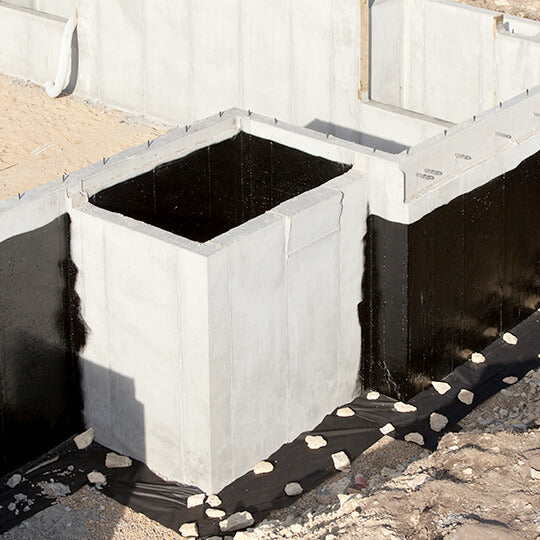Foundation Sealant Basement Coating


48 hours
Beginner
2
Foundation repairs and waterproofing can be an easy fix. Application of Liquid Rubber Foundation Sealant/Basement Coating cures into a seamless waterproof membrane that protects against future potential cracks and leaks. Use on concrete, wood, insulated concrete forms (ICFs) and cinder blocks.


Apply each coat in an alternate direction to the last coat to ensure even coverage.
All surfaces must be structurally sound, clean, dry, and free from anything that would prevent proper adhesion. Cracks, joints, voids, etc. (1/8” or larger) should be pre-filled with a suitable patching material such as a high-quality wood filler, concrete patch material or Liquid Rubber Sealant & Adhesive (or equivalent).
Concrete should be cured for at least 28 days.
Be sure to perform a moisture test prior to application.
Liquid Rubber 3-Course-Method: For all cracks less than 3mm (1/8’’), cold-joints, non- monolithic inside/outside corners, pipes, wall/slab, wall/footing and wall/wall junctures apply a thick 6’’ wide coat and embed 4’’ wide Geo-Textile reinforcement fabric followed by a second coat (known as the 3 Course Method). For all cracks greater than 3mm (1/8’’) fill with backer rod, spray foam, expansion joint caulking or patching materials prior to 3 Course Method. Ensure the surface is smooth and flush and that patching materials have cured as per manufacturers recommendation prior to application of your Liquid Rubber Solution.
Tape-off, block-off, or otherwise mask area’s that are not to receive Foundation Sealant. Remove tape while Sealant is still wet.
Apply Foundation Sealant when temperature is 10ºC/50°F and rising. Use a brush, roller or heavy duty hydraulic piston spray rig (very thick/viscous material) at a final coverage of 20 ft² per G (1.9 sq/m) or 100 ft² per 5G pail (40-60 mils, 1-1.5mm). Generally you can apply 2 heavy coats per day. Apply next coat when dry to touch, is uniform in color and nothing is wet underneath. Tacky is OK. Apply all recommended material. Membrane should be a minimum of 12” above finished grade and down the base of the slab/footing.
Inspect for pinholes, blisters, voids, thin spots or other defects. Repair as necessary. Allow 48 hours to dry before backfilling. It is recommended to apply protection board or drainage board to protect your coating from other trades and work, during backfill, and from thermal expansion and contraction during its life.
Remove tape while coating is still wet and close container to secure leftover product. If spillage occurs, soak up as much material as possible with rags. Clean immediately with soap and water. If spill is dried, scrape off as much as possible with a razor or scraper. Use mineral spirits to weaken product and an appropriate tool such as a wire brush or grinder to mechanically remove. If splashed on the skin immediately wash thoroughly with fresh water. If the product has dried on the skin massage the area with medical grade mineral oil, baby oil or edible oil, then wash with soap and water. If irritation persists seek medical attention.
 NEED SOME HELP?
NEED SOME HELP?